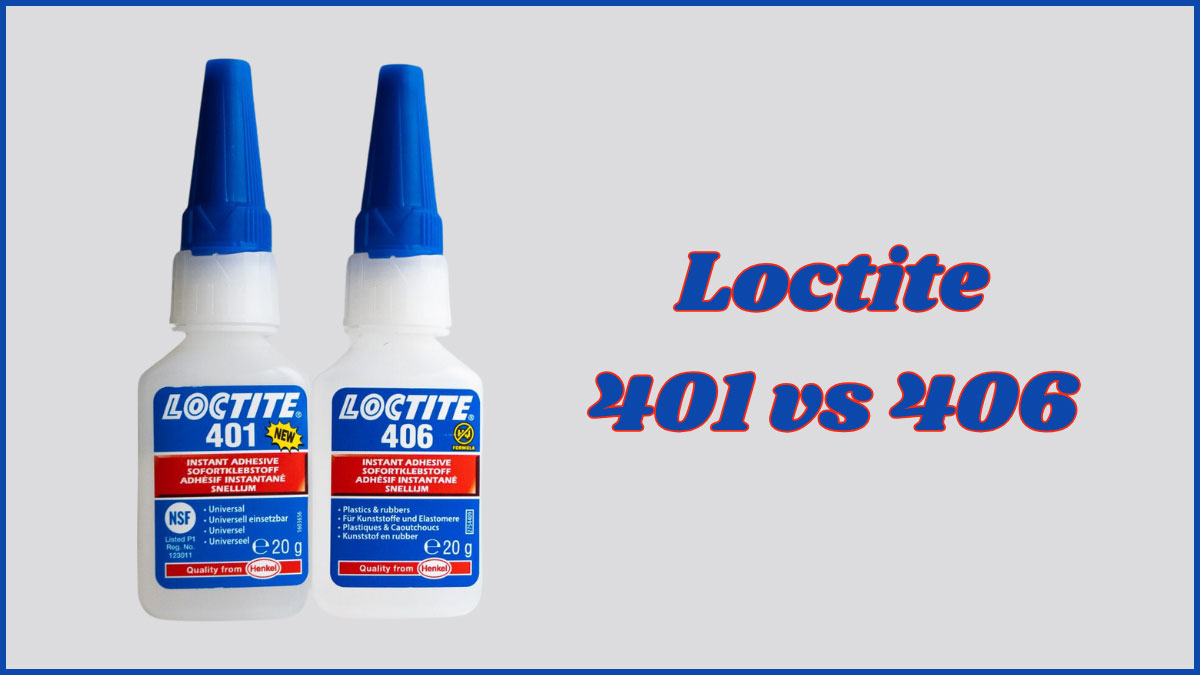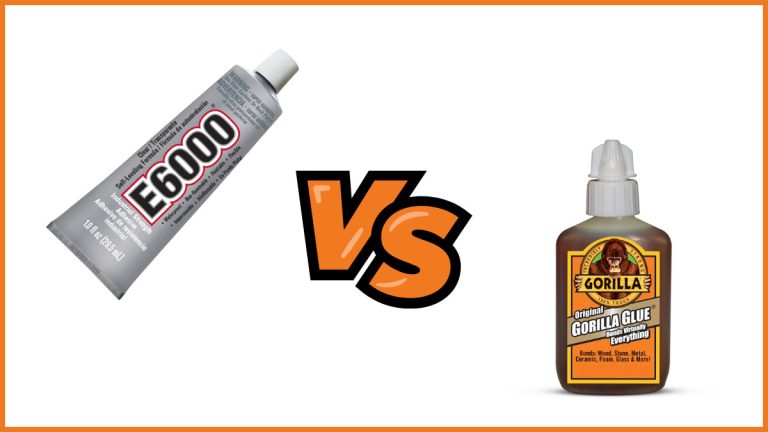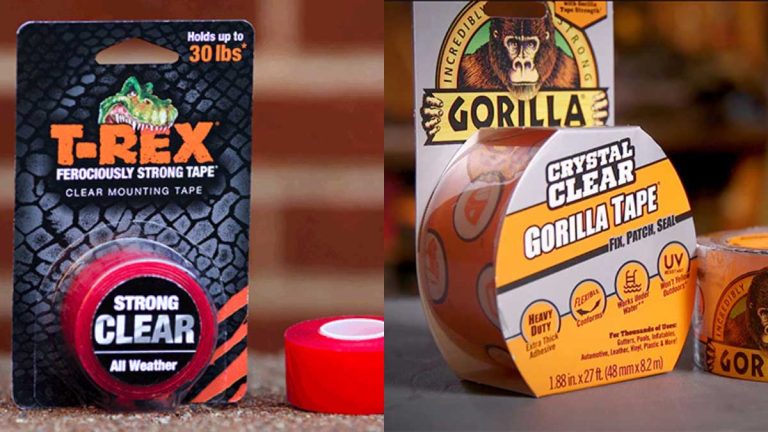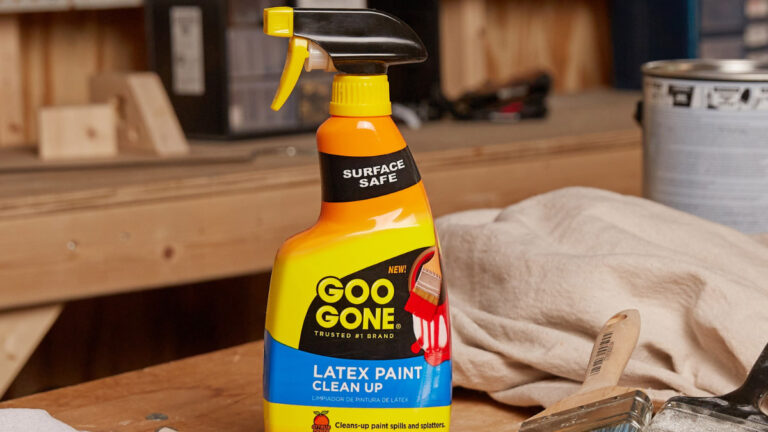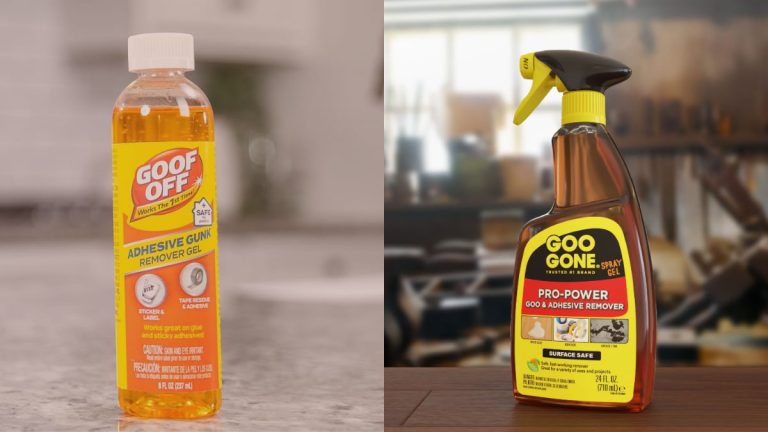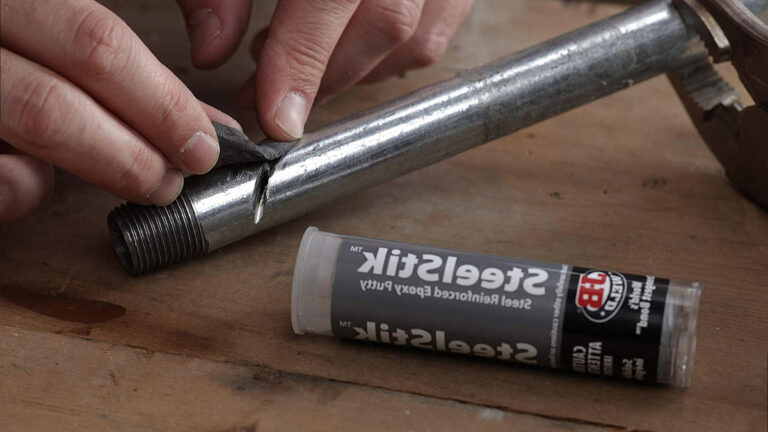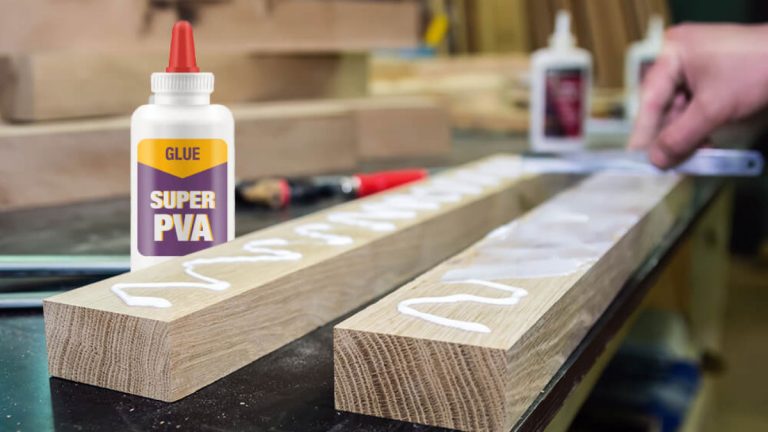Loctite 401 vs 406: Which Adhesive Is Best for Your Project?
Choosing the right adhesive can make or break your project, especially when you need something reliable and strong. Loctite, a trusted name in adhesives, offers a variety of options, but two of the most popular choices are Loctite 401 and Loctite 406. Both are cyanoacrylate adhesives, known for their rapid bonding and versatility, but they cater to slightly different needs.
You might wonder which one suits your specific application better. Whether you’re working with porous materials or need a quick fix for rubber and plastic, understanding the differences between Loctite 401 and 406 will help you make an well-informed choice. Let’s jump into what sets these two adhesives apart and how you can choose the best one for your project.
Key Takeaways
- Versatility and Application: Loctite 401 is a general-purpose adhesive ideal for bonding a wide range of materials including metals, plastics, elastomers, and porous substrates like wood and fabric. Loctite 406 is specialized for quick bonding of rubbers and plastics, offering ultra-low viscosity perfect for closely-fitting parts.
- Bonding Speed: Loctite 401 has a fixture time of 5-20 seconds, making it suitable for various repairs. Loctite 406 bonds even faster, within 2-10 seconds, making it ideal for rapid fixes, particularly involving rubbers and plastics.
- Viscosity Differences: Loctite 401 features low viscosity, making it suitable for applications needing uniform stress distribution. In contrast, Loctite 406 has ultra-low viscosity, allowing it to flow into small gaps for tight bonding.
- Storage Recommendations: Both adhesives should be stored in cool, dry conditions. Ideally, refrigeration is recommended to maintain their effectiveness.
- Use Cases: Choose Loctite 401 for general-purpose bonding across varied materials including porous substrates. Opt for Loctite 406 for specialized tasks requiring quick, strong adhesion of rubbers and plastics.
- Technical Specifications: Both adhesives resist temperatures up to 120°C and cure using humidity. Understanding these specifications helps ensure you select the right adhesive for your project’s specific needs.
Understanding Loctite 401 and 406
Key Properties
Loctite 401
- General Purpose: Designed for bonding a wide range of materials, Loctite 401 is versatile. It works on metals, plastics, elastomers, and porous substrates like wood, paper, leather, and fabric.
- Viscosity: Low viscosity makes it suitable for applications needing uniform stress distribution and high tensile or shear strength.
- Fixture Time: Bonds typically within 5-20 seconds.
- Applications: Ideal for quick repairs. Bonds well to metals, rubber, wood, cardboard, ceramics, and most plastics.
- Storage: Best stored in a refrigerator or a cold area to maintain effectiveness.
- Bonding Capability: Loctite 406 excels in bonding rubber and plastic materials.
- Viscosity: Ultra-low viscosity makes it perfect for bonding closely-fitting parts and facilitates flow into small gaps.
- Fixture Time: Quick bonding within 2-10 seconds.
- Applications: Excellent for rapid fixes in applications involving rubber, plastics, and elastomers.
- Storage: Store in a cool, dry place, preferably in a refrigerator to maximize shelf life.
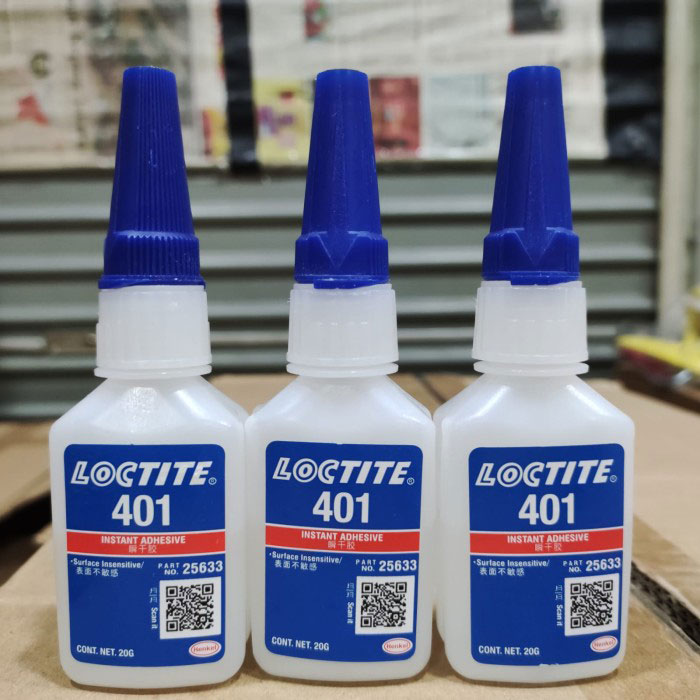
Comparative Table
| Property | Loctite 401 | Loctite 406 |
|---|---|---|
| General Purpose | Bonds various materials | Specializes in rubber and plastics |
| Viscosity | Low viscosity | Ultra-low viscosity |
| Fixture Time | 5-20 seconds | 2-10 seconds |
| Applications | Metals, plastics, elastomers, porous substrates | Rubber, plastics, elastomers |
| Storage | Store in fridge or cold area | Store in cool, dry place |
Usage Tips
- Surface Preparation: Ensure surfaces are clean and dry for optimal bonding.
- Application Method: Apply a small amount of adhesive to one surface and press parts together to activate bonding.
- Safety Precautions: Use in well-ventilated areas, and avoid contact with skin and eyes.
Loctite 401 and 406 both offer rapid bonding and reliable adhesion, but their specific properties make them suitable for different applications. Select Loctite 401 for versatile materials and Loctite 406 for more specialized needs involving rubber and plastics.
Key Features Comparison
Loctite 401 and Loctite 406 both offer excellent bonding capabilities, but they cater to different materials and applications. Understanding their key features can help you choose the right adhesive for your specific needs.
Adhesive Strength
Loctite 401
: Designed for general-purpose bonding, Loctite 401 excels with porous substrates like wood, paper, leather, and fabric. It also bonds well with metals, plastics, and elastomers. The bond strength is high, especially on close-fitting parts.
: Bond Strength on Plastics: Though primarily designed for porous materials, Loctite 401 can achieve higher bond strength on plastics compared to Loctite 406, especially after longer curing times.
Loctite 406
: Specifically designed for bonding plastics and rubbers, including EPDM. Loctite 406 is particularly effective for fast bonding of these materials. Using primers like Loctite 770 enhances its effectiveness on difficult-to-bond plastics.
Application Methods
Loctite 401
: Loctite 401 is versatile, suitable for bonding various materials including metals, plastics, elastomers, wood, paper, leather, and fabric.
Loctite 406
: Loctite 406 is optimized for plastics and rubbers, providing quick and efficient bonding. Use primers for best results with hard-to-bond plastics.
Cure Time
Loctite 401
: Fixture time ranges between 5-20 seconds, depending on the material and environmental conditions.
Loctite 406
: Features a quicker fixture time of 2-10 seconds. Ideal for situations requiring rapid bonding.
| Feature | Loctite 401 | Loctite 406 |
|---|---|---|
| Adhesive Strength | High for porous substrates, good for metals, plastics, elastomers | High for plastics and rubbers (including EPDM) |
| Application Methods | Suitable for a wide range, including porous and non-porous materials | Optimized for plastics and rubbers, use with primers for difficult plastics |
| Cure Time | 5-20 seconds | 2-10 seconds |
Choosing between Loctite 401 and Loctite 406 depends on your specific application needs, from bonding porous materials to achieving fast fixes for plastics and rubbers.
Benefits and Use Cases
When choosing between adhesives, understanding the benefits and specific use cases can streamline your decision-making. Below, we break down the capabilities of Loctite 401 and Loctite 406 so you can select the best adhesive for your needs.
Loctite 401 Applications
- Materials: Loctite 401 is engineered for rapid bonding across a broad spectrum of materials. This includes metals, plastics, elastomers, wood, paper, leather, and fabric.
- Porous Substrates: Particularly effective for bonding porous materials. Examples: wood, paper, leather, fabric.
- Bond Strength: Exhibits higher bond strength compared to Loctite 406, especially after prolonged curing times. For instance, Loctite 401 achieves superior bond strength after 72 hours whereas Loctite 406 peaks at 24 hours.
- Use Cases: Suitable for applications requiring quick assembly with uniform stress distribution. Recommended for materials demanding strong tension and/or shear strength. Ideal for tasks like constructing wooden frames, repairing leather accessories, and bonding metal parts in manufacturing.
Loctite 406 Applications
- Materials: Loctite 406 excels in the rapid bonding of plastics and elastomeric materials. Example materials: EPDM rubber.
- Use Cases: Primarily designed for fast fixes involving plastics and rubbers. Perfect for tasks where time efficiency is critical. Examples: repairing rubber seals, assembling plastic components in electronics, and fixing broken plastic toys.
| Characteristic | Loctite 401 | Loctite 406 |
|---|---|---|
| Materials | Metals, Plastics, Elastomers, Wood, Paper, Leather, Fabric | Plastics, Elastomeric Materials (EPDM rubber) |
| Porous Substrates | Effective | Not specifically optimized |
| Bond Strength After Curing | Higher after 72 hours | Peaks at 24 hours |
| Ideal For | Quick assembly with uniform stress distribution, strong tension and shear strength | Fast bonding of plastics and rubbers |
| Example Uses | Constructing wooden frames, repairing leather accessories, bonding metal parts | Repairing rubber seals, assembling plastic components, fixing plastic toys |
Choosing the right adhesive simplifies your project workflow and enhances durability.
Technical Specifications
When choosing between Loctite 401 and Loctite 406, understanding their technical specifications is crucial. This section provides a detailed comparison to help you make an well-informed choice.
Loctite 401
Loctite 401 is a general-purpose cyanoacrylate adhesive known for its versatility and rapid bonding capabilities across a wide range of substrates. Its key specifications include:
- Chemistry: Cyanoacrylate.
- Viscosity: Low to medium.
- Fixture Time: Typically within seconds.
- Cure Method: Humidity.
- Temperature Resistance: Up to 120°C.
- Color: Transparent to straw-colored liquid.
- Application: Suitable for metals, plastics, elastomers, wood, paper, leather, and fabric.
Loctite 406
Loctite 406 is specifically designed for the rapid bonding of plastics and elastomers. It utilizes ethyl cyanoacrylate chemistry for ultra-fast fixture times. Its key specifications include:
- Chemistry: Ethyl cyanoacrylate.
- Viscosity: Low.
- Fixture Time: 2-10 seconds.
- Cure Method: Humidity.
- Temperature Resistance: Up to 120°C.
- Color: Colorless to transparent, with a straw-colored option.
- Application: Optimized for plastics and rubber.
Material Compatibility
The compatibility of materials with Loctite 401 and Loctite 406 can significantly impact their performance in various applications. Here’s a breakdown:
- Metals: Both adhesives bond effectively, but Loctite 401 offers better general-purpose bonding.
- Plastics: Loctite 406 is optimized for plastics, especially when using primers for difficult-to-bond substrates like polyethylene.
- Rubber: Loctite 406 outperforms, providing rapid bonding for elastomers.
- Porous Materials: Loctite 401 excels in porous substrates like wood, paper, and fabric, ensuring strong adhesion.
Environmental Considerations
Environmental factors can affect the performance of adhesives. Here’s how Loctite 401 and 406 respond:
- Humidity: Both adhesives use humidity for curing, but rapid bond formation occurs in higher humidity.
- Temperature: Both resist temperatures up to 120°C, making them suitable for various environments.
- Color Stability: Transparent to straw-colored, both adhesives maintain color consistency under normal conditions.
This comparison of Loctite 401 and 406 should help you select the right adhesive for your specific needs. Whether working with metal, plastic, or porous materials, knowing these technical specifications ensures optimal bonding results.
Documents and Resources
When selecting an adhesive, having the right documents and resources guides successful application. Accurate data sheets, safety guidelines, and technical resources ensure you understand and properly use products like Loctite 401 and Loctite 406.
Technical Data Sheets (TDS)
Technical Data Sheets provide detailed product information, helping you identify key characteristics and proper usage.
- Loctite 401:
- Viscosity: 100 – 140 mPa.s
- Fixture Time: 5 – 20 seconds
- Temperature Resistance: Up to 120°C
- Applications: Versatile, including rubber, plastics, metals, and porous materials
- Loctite 406:
- Viscosity: 20 – 45 mPa.s
- Fixture Time: 2 – 10 seconds
- Temperature Resistance: Up to 120°C
- Applications: Especially for difficult-to-bond plastics and rubbers
Safety Data Sheets (SDS)
SDS documents detail safety precautions, handling, and storage instructions.
- Hazard Identification: Understand potential hazards associated with each adhesive.
- First-Aid Measures: Instructions in case of accidental exposure.
- Handling and Storage: Proper methods to store and handle the adhesive.
User Manuals and Guides
User manuals and guides provide step-by-step instructions for effective adhesive application.
- Surface Preparation: Clean and dry surfaces ensure optimal bonding.
- Application Techniques: Techniques specific to Loctite 401 and Loctite 406 ensure correct usage.
- Curing Time: Follow recommended curing times for maximum bond strength.
Application Tips
Proper application enhances the performance and longevity of the bonded materials.
- Loctite 401:
- Ideal for multi-material use
- Use for rapid bonding on porous substrates
- Loctite 406:
- Perfect for plastics and rubber
- Use with Loctite 770 primer for difficult-to-bond materials
Product Comparison Chart
| Features | Loctite 401 | Loctite 406 |
|---|---|---|
| Viscosity | 100 – 140 mPa.s | 20 – 45 mPa.s |
| Fixture Time | 5 – 20 seconds | 2 – 10 seconds |
| Temperature Resistance | Up to 120°C | Up to 120°C |
| Applications | General-purpose, multiple materials | Plastics and rubbers, specific uses |
External References
Refer to additional resources for more in-depth information.
- Loctite Official Website: Provides the latest product updates, user manuals, and technical papers.
- Professional Forums: Join discussions with experts for real-world insights and tips.
- Industry Publications: Read about case studies and applications in professional journals.
Having comprehensive documents and resources helps choose the right adhesive and apply it correctly, ensuring project success.
Conclusion
Choosing between Loctite 401 and Loctite 406 depends on the specific materials and requirements of your project. Loctite 401 offers versatility and strength across various substrates, making it ideal for general-purpose bonding. Its ability to bond porous materials like wood and fabric ensures a reliable hold over time.
On the other hand, Loctite 406 excels in bonding plastics and rubber, providing a rapid fixture time and ultra-low viscosity for precise applications. It’s perfect for tasks that demand quick fixes and strong adhesion to elastomers.
Understanding the unique properties of these adhesives will help you make an well-informed choice, ensuring your projects are successful and durable. For more detailed guidance, always refer to the Technical Data Sheets and Safety Data Sheets provided by Loctite.
Frequently Asked Questions
Is Loctite 401 suitable for general-purpose use?
Yes, Loctite 401 is designed for general-purpose use. It effectively bonds a variety of materials including metals, plastics, wood, paper, leather, and fabric, making it versatile for numerous applications.
How long does it take for Loctite 401 to bond?
Loctite 401 has a fixture time of 5-20 seconds, meaning it starts to set quickly. Full strength is typically achieved after 24 hours, ensuring a durable and lasting bond.
What types of materials can Loctite 406 bond?
Loctite 406 excels at bonding plastics and rubber materials. Its ultra-low viscosity and fast fixture time make it ideal for quick fixes involving these substrates.
How fast does Loctite 406 set?
Loctite 406 has a quick fixture time of 2-10 seconds, which allows for rapid assembly and bonding. Full strength is usually realized within 24 hours.
Is Loctite 401 effective for bonding plastics?
Yes, Loctite 401 is effective for bonding plastics as well as metals and porous substrates. Over time, it achieves higher bond strength on plastic materials.
Can Loctite 401 be used on porous materials?
Absolutely. Loctite 401 is particularly effective for bonding porous substrates like wood, paper, and fabric, providing a strong and durable bond.
What are the ideal applications for Loctite 406?
Loctite 406 is perfect for tasks requiring fast bonding of plastics and elastomers. It’s ideal for repairing rubber seals, assembling plastic components, and similar quick fixes.
Why is surface preparation important when using Loctite adhesives?
Proper surface preparation ensures optimal bonding strength. Clean, dry, and well-prepared surfaces help Loctite adhesives to adhere better and form stronger bonds.
Does Loctite provide resources for proper application?
Yes, Loctite offers Technical Data Sheets (TDS) and Safety Data Sheets (SDS) to guide users on proper application techniques and safety measures, ensuring successful outcomes.
Where can I find more information about Loctite adhesives?
For comprehensive resources and detailed information, refer to Loctite’s official website or consult their Technical Data Sheets (TDS) and Safety Data Sheets (SDS) for specific products.

